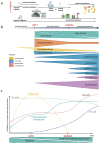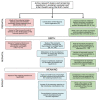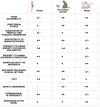Neonatal Immune System Ontogeny: The Role of Maternal Microbiota and Associated Factors. How Might the Non-Human Primate Model Enlighten the Path?
- PMID: 34206053
- PMCID: PMC8230289
- DOI: 10.3390/vaccines9060584
Neonatal Immune System Ontogeny: The Role of Maternal Microbiota and Associated Factors. How Might the Non-Human Primate Model Enlighten the Path?
Abstract
Interactions between the immune system and the microbiome play a crucial role on the human health. These interactions start in the prenatal period and are critical for the maturation of the immune system in newborns and infants. Several factors influence the composition of the infant's microbiota and subsequently the development of the immune system. They include maternal infection, antibiotic treatment, environmental exposure, mode of delivery, breastfeeding, and food introduction. In this review, we focus on the ontogeny of the immune system and its association to microbial colonization from conception to food diversification. In this context, we give an overview of the mother-fetus interactions during pregnancy, the impact of the time of birth and the mode of delivery, the neonate gastrointestinal colonization and the role of breastfeeding, weaning, and food diversification. We further review the impact of the vaccination on the infant's microbiota and the reciprocal case. Finally, we discuss several potential therapeutic interventions that might help to improve the newborn and infant's health and their responses to vaccination. Throughout the review, we underline the main scientific questions that are left to be answered and how the non-human primate model could help enlighten the path.
Keywords: birth; breastfeeding; colonization; immune system maturation; microbiota; non-human primate; pregnancy; probiotics; vaccination; weaning.
Conflict of interest statement
The authors declare that they have no known competing financial interests or personal relationships that could have appeared to influence the work reported in this paper.
Figures




Similar articles
-
Perinatal Antibiotic Exposure Affects the Transmission between Maternal and Neonatal Microbiota and Is Associated with Early-Onset Sepsis.mSphere. 2020 Feb 19;5(1):e00984-19. doi: 10.1128/mSphere.00984-19. mSphere. 2020. PMID: 32075882 Free PMC article.
-
Impact of Delivery Mode on Infant Gut Microbiota.Ann Nutr Metab. 2021 Aug 30:1-9. doi: 10.1159/000518498. Online ahead of print. Ann Nutr Metab. 2021. PMID: 34515049 Review.
-
Maternal vitamin D in pregnancy and infant's gut microbiota: a systematic review.Front Pediatr. 2023 Oct 16;11:1248517. doi: 10.3389/fped.2023.1248517. eCollection 2023. Front Pediatr. 2023. PMID: 37915988 Free PMC article. Review.
-
Maternal microbe-specific modulation of the offspring microbiome and development during pregnancy and lactation.Gut Microbes. 2023 Jan-Dec;15(1):2206505. doi: 10.1080/19490976.2023.2206505. Gut Microbes. 2023. PMID: 37184203 Free PMC article. Review.
-
Gut microbiota and probiotics in maternal and infant health.Am J Clin Nutr. 2011 Dec;94(6 Suppl):2000S-2005S. doi: 10.3945/ajcn.110.001172. Epub 2011 May 4. Am J Clin Nutr. 2011. PMID: 21543533 Review.
Cited by
-
The source of microbial transmission influences niche colonization and microbiome development.Proc Biol Sci. 2024 Feb 14;291(2016):20232036. doi: 10.1098/rspb.2023.2036. Epub 2024 Feb 7. Proc Biol Sci. 2024. PMID: 38320611 Free PMC article.
-
Perinatal Exposure to Tobacco Smoke and Its Association with the Maternal and Offspring Microbiome: A Systematic Review.Healthcare (Basel). 2024 Sep 19;12(18):1874. doi: 10.3390/healthcare12181874. Healthcare (Basel). 2024. PMID: 39337215 Free PMC article. Review.
-
Special Issue "Immune Ontogeny and Vaccination in Early Life: How the Non-Human Primate Model Can Help Expand the Current Knowledge in Pediatric Immunology and Infectious Diseases Research".Vaccines (Basel). 2021 Sep 12;9(9):1014. doi: 10.3390/vaccines9091014. Vaccines (Basel). 2021. PMID: 34579251 Free PMC article.
-
Evaluating Current Molecular Techniques and Evidence in Assessing Microbiome in Placenta-Related Health and Disorders in Pregnancy.Biomolecules. 2023 May 30;13(6):911. doi: 10.3390/biom13060911. Biomolecules. 2023. PMID: 37371491 Free PMC article. Review.
-
Canine Amniotic Fluid at Birth Holds Information about Neonatal Antibody Titres against Core Vaccine Viruses.Vet Sci. 2024 May 23;11(6):234. doi: 10.3390/vetsci11060234. Vet Sci. 2024. PMID: 38921981 Free PMC article.
References
Publication types
LinkOut - more resources
Full Text Sources

